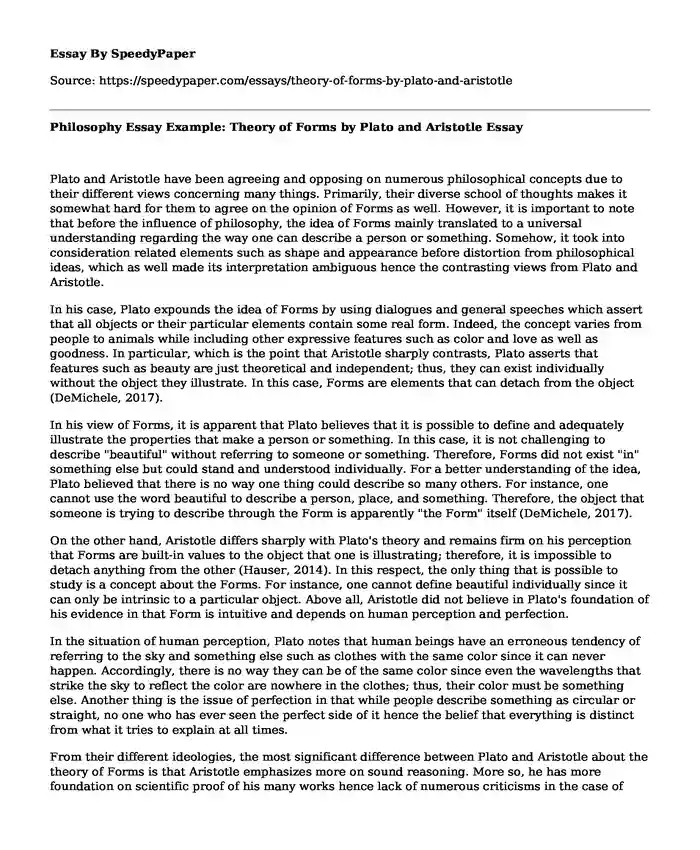
| Type of paper: | Essay |
| Categories: | Philosophy Philosophers Plato |
| Pages: | 3 |
| Wordcount: | 647 words |
Plato and Aristotle have been agreeing and opposing on numerous philosophical concepts due to their different views concerning many things. Primarily, their diverse school of thoughts makes it somewhat hard for them to agree on the opinion of Forms as well. However, it is important to note that before the influence of philosophy, the idea of Forms mainly translated to a universal understanding regarding the way one can describe a person or something. Somehow, it took into consideration related elements such as shape and appearance before distortion from philosophical ideas, which as well made its interpretation ambiguous hence the contrasting views from Plato and Aristotle.
In his case, Plato expounds the idea of Forms by using dialogues and general speeches which assert that all objects or their particular elements contain some real form. Indeed, the concept varies from people to animals while including other expressive features such as color and love as well as goodness. In particular, which is the point that Aristotle sharply contrasts, Plato asserts that features such as beauty are just theoretical and independent; thus, they can exist individually without the object they illustrate. In this case, Forms are elements that can detach from the object (DeMichele, 2017).
In his view of Forms, it is apparent that Plato believes that it is possible to define and adequately illustrate the properties that make a person or something. In this case, it is not challenging to describe "beautiful" without referring to someone or something. Therefore, Forms did not exist "in" something else but could stand and understood individually. For a better understanding of the idea, Plato believed that there is no way one thing could describe so many others. For instance, one cannot use the word beautiful to describe a person, place, and something. Therefore, the object that someone is trying to describe through the Form is apparently "the Form" itself (DeMichele, 2017).
On the other hand, Aristotle differs sharply with Plato's theory and remains firm on his perception that Forms are built-in values to the object that one is illustrating; therefore, it is impossible to detach anything from the other (Hauser, 2014). In this respect, the only thing that is possible to study is a concept about the Forms. For instance, one cannot define beautiful individually since it can only be intrinsic to a particular object. Above all, Aristotle did not believe in Plato's foundation of his evidence in that Form is intuitive and depends on human perception and perfection.
In the situation of human perception, Plato notes that human beings have an erroneous tendency of referring to the sky and something else such as clothes with the same color since it can never happen. Accordingly, there is no way they can be of the same color since even the wavelengths that strike the sky to reflect the color are nowhere in the clothes; thus, their color must be something else. Another thing is the issue of perfection in that while people describe something as circular or straight, no one who has ever seen the perfect side of it hence the belief that everything is distinct from what it tries to explain at all times.
From their different ideologies, the most significant difference between Plato and Aristotle about the theory of Forms is that Aristotle emphasizes more on sound reasoning. More so, he has more foundation on scientific proof of his many works hence lack of numerous criticisms in the case of Plato. However, the two philosophers concur on the idea that Forms exist and illustrate concepts and personalities. However, even if they are demonstrative aspects, Aristotle argues that it is impractical to detach them since they cannot exist undetached from the objects they describe.
References
DeMichele, T. (2017). Plato's Allegory of the Cave and Theory of the Forms Explained. N.p.: Fact/Myth.
Hauser, E. (2014). Aristotle and Plato on the Subject of Forms. N.p.:Sensible Reason.
Cite this page
Philosophy Essay Example: Theory of Forms by Plato and Aristotle. (2022, Mar 18). Retrieved from http://land-repo.site.supplies/essays/theory-of-forms-by-plato-and-aristotle?pname=speedypaper.com
Request Removal
If you are the original author of this essay and no longer wish to have it published on the SpeedyPaper website, please click below to request its removal:
- Essay Sample on Duties towards Compatriots and Non-Compatriots
- Activism in Disability Sports, Free Essay
- Essay Example on Quantum Computing
- Essay Example on Marijuana, Cannabis Sativa
- Theranos - Free Essay Example
- Essay Sample on Distinction between Leadership and Management
- The United Nations was primarily formed as the successor to the League of Nations, which ended its operations after it was defeated in stopping World War II. During its creation, the U.N. began only with 51 member states, but today it is made up of 193 members and is headquartered in the New York City (Mingst & Karns, 2016). Significant initiatives run by the U.N. include providing humanitarian services to a large number of a population across the world, offering emergency food and medical assistance as well as solving conflicts by effective options to maintain peace. Besides, few years after its formation, a number of meetings were conducted where the main agenda was to draft a post-war charter that accurately outlined the most significant roles of the U.N. The membership rules were delineated on the permit where the membership was open to any peace-loving nation that accepted and was willing to undertake the responsibilities contained in the charter as well as the judgment of the organization (Assembly, 2010). The organization is typically structured into five principal organs which include the General assembly that is mainly concerned with the policy-making of the U.N., the Economic and Social Council that primarily concentrates on the environmental, social and economic issues associated with the development goals internationally. The third one is a judicial organ namely the international court of justice, which solves conflicts between members and offers advisory opinions to the organization (Mingst & Karns, 2016). The trustee council was also formed to ensure the self-governance of eleven territories, the UN Secretariat that acts as the administrative organ and lastly the Security Council, whose primary objective is to maintain international peace and security.
Popular categories




